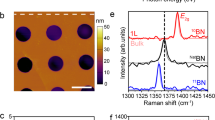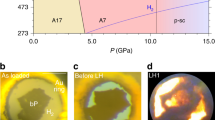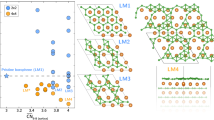Abstract
Attributed to their specific atomic bonding, the soft, graphite-like, hexagonal boron nitride (h-BN) and its superhard, diamond-like, cubic polymorph (c-BN) are important technological materials with a wide range of applications1. At high pressure and temperature, h-BN can directly transform to a hexagonal close-packed polymorph (w-BN)2 that can be partially quenched after releasing pressure. Previous theoretical calculations3,4,5 and experimental measurements (primarily on quenched samples)6,7,8,9 provided substantial information on the transition, but left unsettled questions due to the lack of in situ characterization at high pressures. Using inelastic X-ray scattering to probe the boron and nitrogen near K-edge spectroscopy, here we report the first observation of the conversion process of boron and nitrogen sp2- and p-bonding to sp3 and the directional nature of the sp3 bonding. In combination with in situ X-ray diffraction probe, we have further clarified the structure transformation mechanism. The present archetypal example opens two enormous, element-specific, research areas on high-pressure bonding evolutions of boron and nitrogen; each of the two elements and their respective compounds have displayed a wealth of intriguing pressure-induced phenomena10 that result from bonding changes, including metallization11,12, superconductivity13,14, semiconductivity15, polymerization16 and superhardness2,17,18.
This is a preview of subscription content, access via your institution
Access options
Subscribe to this journal
Receive 12 print issues and online access
$259.00 per year
only $21.58 per issue
Buy this article
- Purchase on Springer Link
- Instant access to full article PDF
Prices may be subject to local taxes which are calculated during checkout




Similar content being viewed by others
References
Pouch, J.J. & Alterovitz, S.A. (eds.) Synthesis and Properties of Boron Nitride (Trans Tech, Aedermannsdorf, Switzerland, 1990).
Bundy, F.P. & Wentorf, J.R.H. Direct transformation of hexagonal boron nitride to denser forms. J. Chem. Phys. 38, 1144–1149 (1963).
Wentzcovitch, R.M. et al. Ab initio study of graphite - diamondlike transitions in BN. Phys. Rev. B 38, 6191–6195 (1988).
Furthmuller, J., Hafner, J. & Kresse, G. Ab-initio calculation of the structural and electronic-properties of carbon and boron-nitride using ultrasoft pseudopotentials. Phys. Rev. B 50, 15606–15622 (1994).
Xu, Y.N. & Ching, W.Y. Calculation of ground-state and optical-properties of boron nitrides in the hexagonal, cubic, and wurtzite structures. Phys. Rev. B 44, 7787–7798 (1991).
Riter, J.R.J. Discussion of shock-induced graphite to wurtzite phase transformation in BN and implications for stacking in graphitic BN. J. Chem. Phys. 59, 1538 (1973).
Johnson, Q. & Mitchell, A.C. First X-ray diffraction evidence for a phase transition during shock-wave compression. Phys. Rev. Lett. 29, 1369–1371 (1972).
Pilyankevich, A.N., Kurdyumov, A.V. & Ostrovskaya, N.F. On the crystallographic irreversibility of some phase transformation in boron nitride. Phys. Stat. Sol. A 116, k1–k5 (1989).
Kurdyumov, A.V. & Oleinik, G.S. Metastable structures of graphite-like boron nitride. Sov. Phys. Crystallogr. 29, 468–469 (1984).
McMillan, P.F. New materials from high-pressure experiments. Nature Mater. 1, 19–25 (2002).
Mailhiot, C., Grant, J.B. & McMahan, A.K. High pressure metallic phases of boron. Phys. Rev. B 42, 9033–9037 (1990).
Chau, R. et al. Metallization of fluid nitrogen and the Mott transition in highly compressed low-Z fluid. Phys. Rev. Lett. 90, 245501 (2003).
Nagamatsu, J. et al. Superconductivity at 39 K in magnesium diboride. Nature 410, 63–64 (2001).
Eremets, M.I. et al. Superconductivity in boron. Science 293, 272–274 (2001).
Eremets, M.I. et al. Semiconducting non-molecular nitrogen up to 240 GPa and its low-pressure stability. Nature 411, 170–174 (2001).
Gregoryanz, E. et al. High-pressure amorphous nitrogen. Phys. Rev. B 64, 502103 (2001).
Wentorf, R.H.J. Cubic form of boron nitride. J. Chem. Phys. 26, 956 (1957).
Solozhenko, V.L. et al. Synthesis of superhard cubic BC2N. Appl. Phys. Lett. 78, 1385–1387 (2001).
Bassett, W.A. et al. Hydrothermal diamond anvil cell for XAFS studies of first-row transition elements in aqueous solution up to supercritical conditions. Chem. Geol. 167, 3–10 (2000).
Watanabe, N. et al. Anisotropy of hexagonal boron nitride core absorption spectra by x-ray Raman spectroscopy. Appl. Phys. Lett. 69, 1370–1372 (1996).
Saito, S., Higeta, K. & Ichinokawa, T. Intensity analysis of boron and nitrogen K-edge spectra for hexagonal boron-nitride by eels. J. Micros-Oxford 142, 141–151 (1986).
Harrison, W.A. Electronic Structure and the Properties of Solids (W.H. Freeman and Company, San Francisco, 1980).
Robertson, J. Electronic structure and core exciton of hexagonal boron nitride. Phys. Rev. B 29, 2131–2137 (1984).
Ma, H. et al. Ab initio Calculation of band-structure, x-ray-emission, quantum yield, and electron-energy-loss spectra of hexagonal boron-nitride. J. Appl. Phys. 73, 7422–7426 (1993).
Shirley, E.L. Theory and simulation of resonant inelastic x-ray scattering in s-p bonded systems: graphite, hexagonal boron nitride, diamond, and cubic boron nitride. J. Electron Spectrosc. 110–111, 305–321 (2000).
Brown, F.C., Bachrach, R.Z. & Skibowski, M. Effect of x-ray polarization at the boron K edge in hexagonal BN. Phys. Rev. B 13, 2633–2635 (1976).
Leapman, R.D. & Silcox, J. Orientation dependence of core edges in electron-energy-loss spectra from anisotropic materials. Phys. Rev. Lett. 42, 1361–1364 (1979).
Jayawardane, D.N. et al. Cubic boron nitride: Experimental and theoretical energy-loss near-edge structure. Phys. Rev. B 64, 115107 (2001).
Mao, W. et al. Bonding changes in compressed graphite. Science 302, 425–427 (2003).
Yagi, T. et al. High-Pressure in situ x-ray-diffraction study of the phase-transformation from graphite to hexagonal diamond at room-temperature. Phys. Rev. B 46, 6031–6039 (1992).
Acknowledgements
The authors would like to thank GSECARS, HPCAT, APS and the National Synchrotron Light Source (NSLS) for beam time and J. Hu for help with the x-ray diffraction experiment conducted at the beamline X17C of NSLS. Use of the HPCAT facility was supported by the US Department of Energy (DOE)-Basic Energy Sciences, DOE-National Nuclear Security Administration, NSF, Department of Defense-Tank-Automotive and Armaments Command, and the W.M. Keck Foundation.
Author information
Authors and Affiliations
Corresponding author
Ethics declarations
Competing interests
The authors declare no competing financial interests.
Rights and permissions
About this article
Cite this article
Meng, Y., Mao, Hk., Eng, P. et al. The formation of sp3 bonding in compressed BN. Nature Mater 3, 111–114 (2004). https://doi.org/10.1038/nmat1060
Received:
Accepted:
Published:
Issue Date:
DOI: https://doi.org/10.1038/nmat1060
This article is cited by
-
Pyro-layered heterostructured nanosheet membrane for hydrogen separation
Nature Communications (2023)
-
Effect of surface termination on the balance between friction and failure of Ti3C2Tx MXenes
npj Materials Degradation (2023)
-
Hexagonal boron nitride-based composites: an overview of processing approaches and mechanical properties
Journal of the Korean Ceramic Society (2023)
-
Two-dimensional diamonds from sp2-to-sp3 phase transitions
Nature Reviews Materials (2022)
-
First-principles study of the anisotropic thermal expansion and thermal transport properties in h-BN
Science China Materials (2021)



